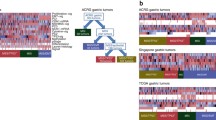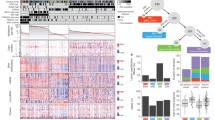Abstract
The catalog of gene alterations in human cancer grows rapidly. Gastric cancer is no exception and displays gene changes in multiple oncogenes, suppressor genes, and DNA repair genes. Clinically relevant molecules whose expression or structure is altered include the plasminogen activator (uPA) and its inhibitor PAI-1 (plasminogen activator inhibitor type 1), the cell-cycle regulator cyclin E, epidermal growth factor (EGF), the apoptosis inhibitor bcl-2, the cell adhesion molecule E-cadherin, and the multifunctional protein beta-catenin. In addition, genetic instability is commonly seen. Gene amplification and protein overexpression of the growth factor receptors c-erbB2 and K-sam may be prognostic factors for intestinal-type and diffuse-type gastric cancer, respectively. The clinical implications of some of the recent findings for diagnosis and therapy are discussed.
Access this chapter
Tax calculation will be finalised at checkout
Purchases are for personal use only
Preview
Unable to display preview. Download preview PDF.
Similar content being viewed by others
References
Lauren P (1965) The two histological main types of gastric carcinoma: diffuse and so called intestinal-type of carcinoma. Acta Pathol Microbiol Scand 64:31–49
Thompson GB, Heerden JA, Sarr MG (1993) Adenocarcinoma of the stomach: are we making progress? Lancet 342:713–718
Wright PA, Williams GT (1993) Molecular biology and gastric carcinoma. Gut 34:145–147
Tahara E (1993) Molecular mechanism of stomach carcinogenesis. J Cancer Res Clin Oncol 119:265–272
Tahara E (1995) Genetic alterations in human gastrointestinal cancers. Cancer 75:1410–1417
Correa P, Shiao Y-H (1994) Phenotypic and genotypic events in gastric carcinogenesis. Cancer Res [Suppl] 54:1941s-1943s
Stemmermann G, Heffelfinger SC, Noffsinger A, Hui YZ, Miller MA, Fenoglio-Preiser CM (1994) The molecular biology of esophageal and gastric cancer and their precursors oncogenes, tumor suppressor genes, and growth factors. Hum Pathol 25:968–981
Fuchs CS, Mayer RJ (1995) Gastric carcinoma. N Engl J Med 333:32–41
Werner M, Becker KF, Keller G, Hofler H (2001) Gastric adenocarcinoma pathomorphology and molecular pathology. J Cancer Res Clin Oncol 127:207–216
Hedrick L, Cho KR, Vogelstein B (1993) Cell adhesion molecules as tumor suppressors. Trends in Cell Biology 3:36–39
Takeichi M (1991) Cadherin cell adhesion receptors as a morphogenetic regulator. Science 251:1451–1457
Grunwald GB (1993) The structural and functional analysis of cadherin calcium-dependent cell adhesion molecules. Curr Opin Cell Biol 5:797–805
Shapiro L, Fannon AM, Kwong PD, Thompson A, Lehmann MS, Grubel G, Legrand JF, Als-Nielsen J, Colman DR, Hendrickson WA (1995) Structural basis of cell-cell adhesion by cadherins. Nature 374:327–337
Nagar B, Overduin M, Ikura M, Rini JM (1996) Structural basis of calcium-induced E-cadherin rigidiflcation and dimerization. Nature 380:360–364
Behrens J, Mareel MM, Van Roy FM, Birchmeier W (1989) Dissecting tumor cell invasion epithelial cells acquire invasive properties after the loss of uvomorulin-mediated cell-cell adhesion. J Cell Biol 108:2435–2447
Frixen UH, Behrens J, Sachs M, Eberle G, Voss B, Warda A, Lochner D, Birchmeier W (1991) E-cadherin-mediated cell-cell adhesion prevents invasiveness of human carcinoma cells. J Cell Biol 113:173–185
Vleminckx K, Vakaet JL, Mareel M, Fiers W, Van Roy F (1991) Genetic manipulation of E-cadherin expression by epithelial tumor cells reveals an invasion suppressor role. Cell 66:107–119
Hirohashi S (1998) Inactivation of the E-cadherin-mediated cell adhesion system in human cancers. Am J Pathol 153:333–339
Mayer B, Johnson JP, Leitl F, Jauch KW, Heiss MM, Schildberg FW, Birchmeier W, Funke I (1993) E-cadherin expression in primary and metastatic gastric cancer down-regulation correlates with cellular dedifferention and glandular disintegration. Cancer Res 53:1690–1695
Shimoyama Y, Hirohashi S (1991) Expression of E- and P-cadherin in gastric carcinomas. Cancer Res 51:2185–2192
Berx G, Becker KF, Hofler H, van Roy F (1998) Mutations of the human E-cadherin (CDH1) gene. Hum Mutat 12:226–37
Becker I, Becker K-F, Röhrl MH, Minkus G, Schütze K, Höfler H (1996) Single-cell mutation analysis of tumors from stained histologic slides. Lab Invest 75:801–807
Muta H, Noguchi M, Kanai Y, Ochiai A, Nawata H, Hirohashi S (1996) E-cadherin gene mutations in signet ring cell carcinoma of the stomach. Jpn J Cancer Res 87:843–848
Becker K, Höfler H (1995) Frequent somatic allelic inactivation of the E-cadherin gene in gastric carcinomas. J Natl Cancer Inst 87:1082–1084
Ramaekers F, Haag D, Jap P, Vooijs PG (1984) Immunochemical demonstration of keratin and vimentin in cytologic aspirates. Acta Cytol 28:385–392
Ninomiya I, Yonemura Y, Endo Y (1995) Detection of E-cadherin mRNA from preoperative peritoneal cavity washings as diagnosis of peritoneal metastasis of gastric cancer. In: Nishi M, Sugano H, Takahashi T (eds) Proceedings 1st International Gastric Cancer Congress, Kyoto, Japan. Monduzzi Editore, Bologna, pp 795–799
Schuhmacher C, Becker KF, Reich U, Schenk U, Mueller J, Siewert JR, Hofler H (1999) Rapid detection of mutated E-cadherin in peritoneal lavage specimens from patients with diffuse-type gastric carcinoma. Diagn Mol Pathol 8:66–70
Vollmers HP, Zimmermann U, Krenn V, Timmermann W, Illert B, Hensel F, Hermann R, Thiede A, Wilhelm M, Ruckle-Lanz H, Reindl L, Muller-Hermelink HK (1998) Adjuvant therapy for gastric adenocarcinoma with the apoptosis-inducing human monoclonal antibody SC-1 first clinical and histopathological results. Oncol Rep 5:549–552
Handschuh G, Candidus S, Luber B, Reich U, Schott C, Oswald S, Becke H, Hutzier P, Birchmeier W, Hofler H, Becker KF (1999) Tumour-associated E-cadherin mutations alter cellular morphology, decreasecellular adhesion and increase cellular motility. Oncogene 18:4301–4312
Becker, KF, Kremmer, E, Eulitz, M, Becker, I, Handschuh, G, Schuhmacher, C, Müller, W, Gabbert, HE, Ochiai, A, Hirohashi, S, Höfler, H (1999) Analysis of E-cadherin in diffusetype gastric cancer using a mutation-specific monoclonal antibody. Am J Pathol 155:1803–1809
Becker KF, Kremmer E, Eulitz M, Schulz S, Mages J, Handschuh G, Wheelock MJ, Cleton-Jansen AM, Hofler H, Becker I (2002) Functional allelic loss detected at the protein level in archival human tumors using allele-specific E-cadherin monoclonal antibodies. J Pathol 197:567–574
Senekowitsch-Schmidtke R, Schuhmacher C, Becker KF, Nikula TK, Seidl C, Becker I, Miederer M, Apostolidis C, Adam C, Huber R, Kremmer E, Fischer K, Schwaiger M (2001) Highly specific tumor binding of a 213Bi-labeled monoclonal antibody against mutant E-cadherin suggests its usefulness for locoregional alpha-radioimmunotherapy of diffuse-type gastric cancer. Cancer Res 61:2804–2808
Author information
Authors and Affiliations
Editor information
Editors and Affiliations
Rights and permissions
Copyright information
© 2003 Springer-Verlag Berlin Heidelberg
About this paper
Cite this paper
Höfler, H., Becker, KF. (2003). Molecular Mechanisms of Carcinogenesis in Gastric Cancer. In: Allgayer, H., Heiss, M.M., Schildberg, F.W. (eds) Molecular Staging of Cancer. Recent Results in Cancer Research, vol 162. Springer, Berlin, Heidelberg. https://doi.org/10.1007/978-3-642-59349-9_5
Download citation
DOI: https://doi.org/10.1007/978-3-642-59349-9_5
Publisher Name: Springer, Berlin, Heidelberg
Print ISBN: 978-3-642-63945-6
Online ISBN: 978-3-642-59349-9
eBook Packages: Springer Book Archive




